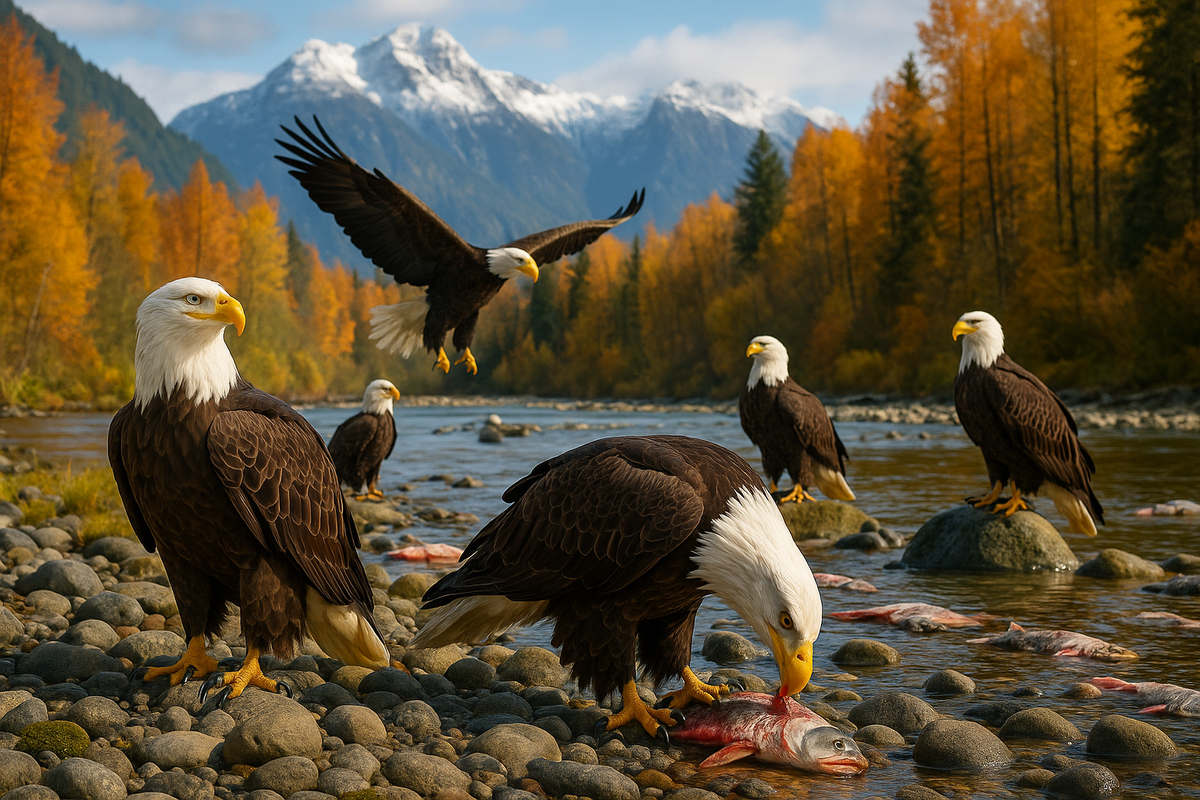
By Elke Porter | WBN News Sea to Sky | April 23, 2025
Each winter, Brackendale Eagles Park in British Columbia becomes a world-renowned gathering place for one of nature’s most majestic birds—the bald eagle. Nestled in the Squamish River watershed, amid the dramatic Coast Mountains, the park lies in a valley carved deep by the Squamish River as it winds through the Pacific Ranges toward the coast.
From November through February, hundreds—sometimes thousands—of bald eagles converge on this region to feast on spawning chum salmon in the Squamish, Cheakamus, and Mamquam Rivers. The riparian zone offers prime habitat for roosting, perching, and feeding, creating the perfect sanctuary for these birds. In fact, the area set a world record in 1994 when 3,769 bald eagles were counted during a single winter season.
Peak viewing takes place from November to December, with the best public vantage point being the Eagle Run dyke across from the Easter Seals Camp on Government Road in Brackendale. While the park itself—located primarily on the west side of the Squamish River—remains closed to the public during eagle season to protect the sensitive ecosystem, visitors can still enjoy incredible views from outside its boundaries.
To preserve this unique environment, Brackendale Eagles Park prohibits camping, campfires, and mechanized recreation. Fishing is permitted in designated areas, and limited commercial recreation—such as wildlife-focused river rafting—is allowed with a Park Use Permit.
🦅 Where the Eagles Go in Spring
After winter, as the salmon runs dwindle and the Squamish River Valley warms, most bald eagles disperse from Brackendale to return to their nesting territories across British Columbia, the Pacific Northwest, and even interior regions. These nesting areas are often located near freshwater sources with ample food supply and tall trees for roosting and nesting.
⛔️ Why You're Encouraged Not to Disturb Them
Spring is nesting season, typically from March through July. During this time:
- Eagles become more territorial and sensitive to disturbance.
- Human interference (including noise or close approaches) can cause stress or even lead parents to abandon nests.
- In protected areas like Brackendale Eagles Park, access remains restricted or heavily controlled to minimize disturbance.
✅ How to Respect Nesting Eagles
- Observe from a safe distance using binoculars or a zoom lens.
- Stick to designated viewing areas.
- Avoid loud noises or flying drones near nests.
- Follow local wildlife safety and viewing guidelines.
Beyond eagles, the park is home to a diverse array of wildlife including black bears, elk, cougars, and over 140 bird species. Reptiles, amphibians, and small mammals also thrive in this ecologically rich habitat.
Visitors are encouraged to follow responsible recreation guidelines and honour Indigenous connections to the land. Brackendale isn’t just a place to see eagles—it’s a reminder of the importance of preserving wild spaces for future generations.
#Brackendale Eagles #Bald Eagle Watching #Squamish Nature #Wildlife BC #Eagle Run Dyke #Birding Canada #Eco Tourism BC #Pacific Northwest Nature #WBN News Sea to Sky #Elke Porter
Connect with Elke at Westcoast German Media or on LinkedIn: Elke Porter or contact her on WhatsApp: +1 604 828 8788

